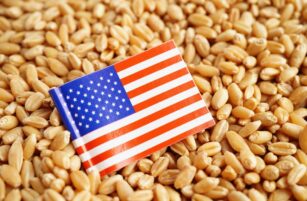Insight Focus
- FAO Food Price Index hits record high.
- Over 25% of Africans face hunger: Red Cross.
- Russia extends fertiliser export licensing scheme to the end of 2022.
Global trade shrank 2.8% on the month in March largely as a result of the Russian invasion of Ukraine, according to the Germany-based Kiel Institute for the World Economy (IFW).
The IFW said Russian exports fell 5% and imports 9.7% as a result of sanctions. At Russia’s three largest ports, St. Petersburg, Vladivostok, and Novorossiysk, container freight traffic had already slumped by half, it added.
The disruption to trade caused by the conflict was one of the main factors driving the UN Food and Agriculture Organisation’s Food Price Index to a record high in March. The FAO said the index leapt 26.6% from February, reflecting fresh highs for the vegetable oils, cereals and meat sub-indices, while those of sugar and dairy products also rose significantly.

Ukraine’s Grain Exports Slump
As for Ukraine itself, the APK Inform website quoted the Ukrainian Agriculture Ministry as saying the country’s March grain exports had shrunk fourfold from February.
However, Prime Minister Denys Shmyhal was bullish about spring planting. The official Ukrinform news agency quoted him as saying that the sowing campaign had started in 20 regions compared with 15 a year earlier and that the planned area to be sown was 80% of the area sown last year.
However, the FAO forecast in its Cereal Supply and Demand Brief that wheat production in would fall below the five-year average, primarily because at least 20% of the winter planted area may not be harvested due to direct destruction, constrained access or a lack of resources to harvest crops. It said it also expected yields to decline in 2022 due to disrupted access to inputs and farmland.
For Russia, continued conducive weather has bolstered the FAO’s harvest expectations and it’s predicting wheat production above the five-year average. The FAO added that its outlook remained preliminary particularly because of uncertainties surrounding the importation of some agricultural inputs.

Exporting any agricultural commodities is proving difficult for Ukraine with its Black Sea ports blockaded. Alternative routes are proving difficult. Reuters
reported that around 1,100 rail wagons carrying grain were stuck near the main rail border crossing with Poland, unable to transport their cargo abroad. Reuters cited industry insiders and the government as saying the key issue was the sheer volume of goods needing an alternative route, which was causing shortages of everything from rail cars to staff. Ukraine exported 98% of its grain via the Black Sea before the invasion.
The situation was being compounded by logistical issues, such as differences in gauges between the rail systems in Ukraine and its neighbours.
The difficulties of maritime shipping in the Black Sea also grew after the Joint War Committee, which comprises syndicate members from the Lloyd’s Market Association and representatives from the London insurance company market added all of Russia’s waters to its list of areas deemed high risk.
Highlighting the risk to shipping in the region, defence ministers from Black Sea coastal countries held a video call to discuss mines floating in the sea among other matters, Reuters reported, citing the Turkish Defence Ministry.

Warnings of Hunger
In an address to the Irish parliament, Ukrainian President Volodymyr Zelensky accused Russia of using hunger as a weapon, Irish broadcaster RTE reported.
“Ukraine is one of the leading food supplying countries in the world. Without our exports, this is not just about the deficit and the threat of hunger, for more than dozens of countries – Asia and Africa – but even more because there will be a shortage of food and the prices will go up and this is reality for the millions of people who are hungry and it will be more difficult for them to feed their families, especially in Northern Africa,” Zelensky said.
The International Committee of the Red Cross said more than a quarter of Africans were facing a food security crisis.
“We are scaling up our operations in countries like Somalia, Kenya, Nigeria and Burkina Faso and many others to try and help as many people as we can, but the number of people going without food and water is staggering,” the ICRC’s head of global operations, Dominik Stillhart, said.
Drive for Food Security

In North Africa, Egypt’s imports of Russian wheat rose in March despite the war in Ukraine. Egypt received 479.2k tonnes of wheat from Russia in March, 24% more than a year earlier, freight data seen by Reuters showed. Wheat imports from Ukraine were 42% less at 124.5k tonnes. The Al Ahram news website quoted EU Ambassador Christian Berger as saying the bloc would give Egypt a grant worth EUR 100 million (USD 109 million) in response to the surge in food prices caused by the Ukraine crisis.
Al Ahram earlier reported that the Egyptian government had allocated around USD 60 million for the procurement of wheat from domestic farmers.
Tunisia too is looking to reduce grain imports and strengthen food security by incentivising grains production at home. The Agriculture Ministry announced increases in the prices of grain purchased from farmers for the 2022 harvest. The price of durum wheat will be raised 30%, that of soft wheat 25% and those of barley and triticale by 16%, the official TAP news agency reported.
Elsewhere in the Arab world, a top official from Oman Flour Mills Company was quoted by Zawiya as saying Oman would not suffer a shortage of wheat despite Russia-Ukraine conflict. The official said the company has signed agreements with three countries to import 160k tonnes of wheat.
Neighbouring Saudi Arabia managed to procure 625k tonnes of wheat in an international tender, Reuters reported, citing the Saudi Grains Organization. The wheat will be delivered between September and November.
US Success and Failure
Private US exporters reported sales of 1.08m tonnes of corn for delivery to China, the US Department of Agriculture said. Of the total, 676k tonnes is for delivery during the 2021/22 marketing year and 408k tonnes is for delivery during the 2022/23 marketing year. Reuters said it was China’s largest purchase of US corn since May 2021.
However, US farmers, on a trade tour in Cuba, said on they would like to sell more wheat and other farm products to the impoverished Caribbean island as a global food crisis looms, but that US sanctions hamper new deals because they deny Cuba credit, Reuters reported.
Indian Export Success
By contrast, wheat exports from India are booming. Reuters quoted traders as saying Indian wheat exports hit a record high of 7.85m tonnes in the fiscal year to the end of March, almost four times the 2.1m tonnes exported a year earlier.
Indian mills have signed contracts to export 7.2m tonnes of sugar in 2021/22 without government subsidies, the Indian Sugar Mills Association said, adding that market expectations were that India would export 8.5m tonnes by the end of the season in September. Both these figures beat the previous record high in 2020/21 when India exported 7.1m tonnes.
Fertiliser Supply
One of the key concerns in the food supply chain has been fertiliser supply. Russia, a major fertiliser producer, will extend the licensing of fertiliser exports until the end of 2022 to support domestic farmers, the Interfax news agency quoted the Agriculture Ministry as saying.
On the other hand, Tunisia’s phosphate production doubled year on year to 1.3m tonnes in the first quarter of 2022, a senior official at state-run Gafsa Phosphate told Reuters.
Other Insights That May Be of Interest…
Russian Food Self-Sufficiency: Reality or a Potemkin Village?
Ukraine Crisis Adds Another Twist to Food Insecurity Spiral
Russian Invasion Could Make India a Major Global Wheat Player
Russian Invasion Sparks Packaging Shortage for Food & Bev Producers
Explainers That May Be of Interest…













